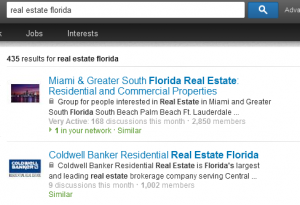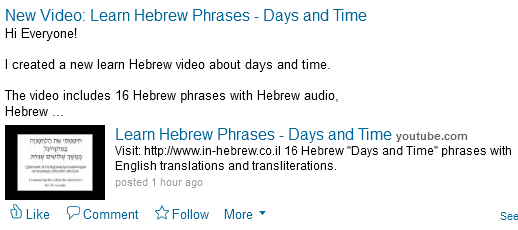LinkedIn Groups: Using Them To Benefit Your Business
Ready to make the most of your LinkedIn groups? Read on!
You’re probably on LinkedIn. You probably have some connections – whether it’s 18 or 18 million.
(Yes, 18 million. I recently joined a LinkedIn group for a client and got back a message from the head of the group saying, “If you need an Introduction to any of the 18 million members in my network, please let me know.” It’s hard for me to imagine that he knows most of those 18 million members well enough for an introduction to be useful, but I digress… this post is about how to use LinkedIn groups, not LinkedIn contacts.)
You also probably belong to some LinkedIn groups. The question is: do your LinkedIn groups do anything for you besides decorate your profile and clog up your inbox with daily digest emails?
Here’s how to get on the path to making them work for you.
1) Finding the right groups
There are two kinds of groups you might want to join – each with a different purpose.
The first type of group is a group of colleagues. For a caterer, this would be a group where the other members are caterers. For a lawyer, this would be a group where the other members are lawyers.
You join these groups for two reasons:
a) For group support, advice and camaraderie
If you’re a Philadelphia caterer, you might want a community to ask about the best place to buy local herbs wholesale. You might want to order ingredients online, but want to hear from other caterers who have done so and what their experiences have been. You might want to commiserate when business is low because of a recession – and to hear what caterers in other areas of the country have done to stay afloat.
b) To establish your reputation as an expert
Now you’re a lawyer. If you answer the legal questions of the other lawyers in the group – solid, thought-out answers that point them in the right directions; if you share articles and posts that inform and educate the other members of the group, especially if they’re your own articles – you will establish yourself as an expert in your field.
Why do you want to be known as an expert (aside from the obvious ego boosting benefits)?
If your colleagues view you as an expert, they may be inclined to refer appropriate business your way. They may also turn to you for consulting if they’re faced with a professional challenge.
The second type of group is a group of potential clients. For our Philadelphia-based caterer, this could be a group of small businesses based in the Philadelphia area (often businesses need catering for meetings and events). For a lawyer, this could be a group for the field in which he specializes. For example, for a real-estate lawyer, this would be a group for real-estate agents.
You join these groups to expose yourself and your expertise to potential clients. If the real-estate agents see how professional and expert you are as a lawyer, they may be inclined to call you the next time they are looking for a new real-estate lawyer. They may also recommend you to colleagues who are looking.
So let’s find some groups…
Enter whatever type of group you’re looking for into the search box at the top of your LinkedIn page. Click on the little magnifying glass. You will get a combination results page – people, jobs, groups, everything.

Narrow it down. Click on the “Groups” item in the menu bar to the left and you will see:

There you go. Just groups. This may still leave you with way too many groups to look at (see that number? 19,777!?), so you might want to refine your search. Let’s try “real estate florida.”

Okay, well, 435 is better than 19,777, no?
Clearly, you cannot possibly be active in 15 groups at a time (you do have a job, right?) Therefore, it’s recommended to target 2 to 4 groups and become an active presence. When selecting a group, it’s good to look for active groups – meaning there are actually regular discussions happening – but depending on your motivations you may not want it to be *too* active. For example, if there are 100 discussions a day, who is going to see what you have to say? (If you do join a group like that, there is a way to make the most of it – read on!)
So, you’ve joined your groups. Now let’s go on to the nest step…
2) Deciding what to share with the group
This is assuming you’ve joined the group to establish yourself as an expert in the field and attract clients (if you’ve joined for moral support, you know what you want to share).
First of all, if you write any content for your field – on your site or on other websites – you’re going to want to share that.
Aside from your own writing, find other articles and posts in your field – topics that will be helpful to the other group members – and share those as well.
Where do you find them?
Use search engines to start with; Google your topic and check out what comes up. After you’ve made a list of a few relevant links, set up a Google Alert for yourself, so Google can do the work and you can sit back and receive targeted results.

Choose how often you want the alert –once weekly should be sufficient. That way it won’t clog up your inbox or distract you. You can pick one day a week to go through all the links in the alert email and prep your “content to share document” for the coming week.
What should be on your “content to share document”? The title of your discussion, the content of your discussion, and the link you want to share (if there is one – you can also share thought-provoking ideas and start interesting discussions without a link for further reading – whatever fits the situation).
Note that while you can have a very long post, only about 139 characters will make it into the excerpt that appears on the group’s discussion page. And only the title will appear in the email digests. So it is critical to make your title stand out – and those first 139 characters should draw the reader in.
One tip for utilizing those 139 characters is to use the Enter key. Linkedin Groups count entire empty lines as only a character or two. So if you space out the beginning of your post content, you can occupy more real estate and draw people’s eyes. Compare this standard post:
And this spaced out post:
Which attracts your attention more?
Important tip: Make sure that your discussion title differs from your link title – if you don’t, LinkedIn will remove your discussion title as an attempt to avoid redundancy.
Just for you, we put together a LinkedIn group posts prep template for you to use. Just copy it to your own Google Drive. There’s an example in there already. Follow the pattern, and when you actually want to post something, copy-paste to the right fields in your LinkedIn group page. The column to the right of the “Post” column is set up so it shows the number of characters in the post, and you can get an idea of what will show up on the Discussions page.
Now that you have all your amazing content ready to share, the last question is:
3) When are you going to post?
I mean, after all this hard work setting everything up, you want people to actually SEE what you post, right?
For very active groups, this is even more critical. Check out this guide to timing your LinkedIn posts for maximum exposure – figuring out when daily digest emails are sent out for your groups, and timing your post publication accordingly.
Have any other tips for getting business value out of LinkedIn Groups? Share with us in the comments below!
 Submitted by Aviva
Submitted by Aviva



